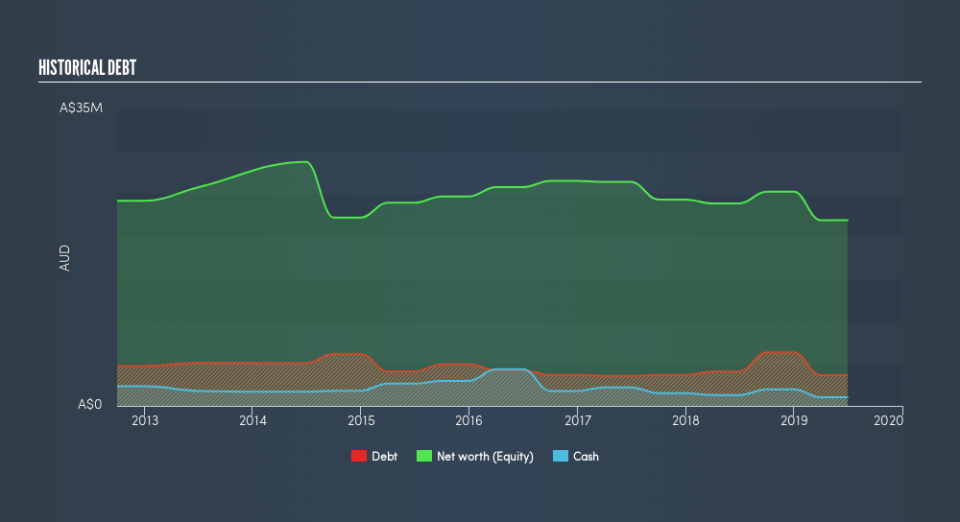Atlas Pearls (ASX:ATP) Seems To Be Using An Awful Lot Of Debt

David Iben put it well when he said, 'Volatility is not a risk we care about. What we care about is avoiding the permanent loss of capital.' So it seems the smart money knows that debt - which is usually involved in bankruptcies - is a very important factor, when you assess how risky a company is. We can see that Atlas Pearls Ltd (ASX:ATP) does use debt in its business. But the more important question is: how much risk is that debt creating?
What Risk Does Debt Bring?
Debt is a tool to help businesses grow, but if a business is incapable of paying off its lenders, then it exists at their mercy. Ultimately, if the company can't fulfill its legal obligations to repay debt, shareholders could walk away with nothing. However, a more usual (but still expensive) situation is where a company must dilute shareholders at a cheap share price simply to get debt under control. Of course, debt can be an important tool in businesses, particularly capital heavy businesses. The first step when considering a company's debt levels is to consider its cash and debt together.
Check out our latest analysis for Atlas Pearls
What Is Atlas Pearls's Net Debt?
The image below, which you can click on for greater detail, shows that Atlas Pearls had debt of AU$3.62m at the end of June 2019, a reduction from AU$4.06m over a year. However, because it has a cash reserve of AU$1.02m, its net debt is less, at about AU$2.60m.
How Healthy Is Atlas Pearls's Balance Sheet?
We can see from the most recent balance sheet that Atlas Pearls had liabilities of AU$6.47m falling due within a year, and liabilities of AU$2.85m due beyond that. Offsetting this, it had AU$1.02m in cash and AU$791.8k in receivables that were due within 12 months. So its liabilities outweigh the sum of its cash and (near-term) receivables by AU$7.51m.
This deficit casts a shadow over the AU$4.67m company, like a colossus towering over mere mortals. So we'd watch its balance sheet closely, without a doubt After all, Atlas Pearls would likely require a major re-capitalisation if it had to pay its creditors today.
In order to size up a company's debt relative to its earnings, we calculate its net debt divided by its earnings before interest, tax, depreciation, and amortization (EBITDA) and its earnings before interest and tax (EBIT) divided by its interest expense (its interest cover). This way, we consider both the absolute quantum of the debt, as well as the interest rates paid on it.
Even though Atlas Pearls's debt is only 2.2, its interest cover is really very low at 2.3. This does have us wondering if the company pays high interest because it is considered risky. Either way there's no doubt the stock is using meaningful leverage. Notably, Atlas Pearls made a loss at the EBIT level, last year, but improved that to positive EBIT of AU$861k in the last twelve months. There's no doubt that we learn most about debt from the balance sheet. But you can't view debt in total isolation; since Atlas Pearls will need earnings to service that debt. So when considering debt, it's definitely worth looking at the earnings trend. Click here for an interactive snapshot.
Finally, a company can only pay off debt with cold hard cash, not accounting profits. So it's worth checking how much of the earnings before interest and tax (EBIT) is backed by free cash flow. Over the last year, Atlas Pearls saw substantial negative free cash flow, in total. While that may be a result of expenditure for growth, it does make the debt far more risky.
Our View
On the face of it, Atlas Pearls's conversion of EBIT to free cash flow left us tentative about the stock, and its level of total liabilities was no more enticing than the one empty restaurant on the busiest night of the year. Having said that, its ability to grow its EBIT isn't such a worry. After considering the datapoints discussed, we think Atlas Pearls has too much debt. That sort of riskiness is ok for some, but it certainly doesn't float our boat. While Atlas Pearls didn't make a statutory profit in the last year, its positive EBIT suggests that profitability might not be far away.Click here to see if its earnings are heading in the right direction, over the medium term.
If you're interested in investing in businesses that can grow profits without the burden of debt, then check out this free list of growing businesses that have net cash on the balance sheet.
We aim to bring you long-term focused research analysis driven by fundamental data. Note that our analysis may not factor in the latest price-sensitive company announcements or qualitative material.
If you spot an error that warrants correction, please contact the editor at editorial-team@simplywallst.com. This article by Simply Wall St is general in nature. It does not constitute a recommendation to buy or sell any stock, and does not take account of your objectives, or your financial situation. Simply Wall St has no position in the stocks mentioned. Thank you for reading.

 Yahoo Finance
Yahoo Finance 
